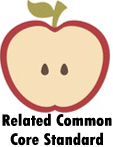Allegory Worksheets
Related ELA Standard: L.7.5.A

An allegory is a literary device that uses a metaphor where a story occurs within a story. This is where the story told implies a much big point it is aimed at history or everyday life. This is often used to explore real world occurrences or hot button issues. Authors use this device to varying degrees. Sometimes it is very subtle and almost hard to spot and other times the comparison is undeniable. One classic work of literature that is centered around technique is Animal Farm by George Orwell. In this work, Orwell likens the animal population on a farm to societal class system of the communist form of government.
You will find allegories used to explore topics that people are deeply passionate about such as politics, religion, and finances. By using the hidden message, authors can soften the blow of examining these sensitive topics. It is often easier to educate your readers on topics they are not familiar with by comparing them to situations that are commonly known. This technique is highly effective to craft messages that are thought of as sophisticated and complex into easy to digest stories for readers.
Allegory Worksheets To Print:
Fables
- An allegory is a story with two layers. The "outer" layer is
the events that occur in the story. The "deeper" layer is
the symbolism or moral of the story, the greater meaning that the
characters and events of the story represent. Fables often use this technique
because the animals stand in for humans, and each brief story
conveys a lesson or moral.
Create Them -
You will be given a selection of morals to choose from and then work on your own story.
Wizard of Oz
- The Wonderful Wizard of Oz, by L. Frank Baum, was an allegorical commentary
on politics in America at the turn of the 20th century. Based on the historical
context of the book, can you identify what each item pictured below
represents?
Wall-e
- Wall-e is partly an allegorical story. What is the message? How is this message
illustrated by the story? Can you identify what any of the elements of the movie
represent?
Zootopia -
The argument has been made that in Disney's animated feature Zootopia,
"speciesism" is an allegory for racism. Do you agree? Why or why not? Support
your answer with evidence from the film.
Deep Thoughts
- We examine the essence of the concept of an allegorical story.
Fable vs. Parable
- Complete the chart to understand the similarities and
differences between fables and parables.
Allegory vs. Symbol
- Allegory and symbolism are very similar concepts, but they are not the same.
Complete the worksheet below to deepen your understanding of how these
two literary devices differ.
Common Confusion - Differentiate between allegory and these other commonly
confused concepts.
Why Use It?
- Why do you think a writer would choose
to use allegory in order to tell a story? What are the advantages and
disadvantages of presenting ideas in this way?
Thinking Allegorically
- What is an important life lesson that you have learned that you
feel like everyone ought to know?
Well Known Examples of Allegory
One of my favorite works of science fiction is an allegory and I did not ever know until I studied Middle Eastern history in college. When evaluated within in the confines of Frank Herbert’s work Dune it can be seen as a roomy allegory for the Middle Eastern History. The story is set thousands of years in the future with humans scattered all over the universe. Every planet is governed by a different group of people that are united under the single empire of an emperor. In this futuristic world the economy is based on spice. Spice has a wide range of uses but is used to lengthen the human life span. In this story spice is an allegory for oil. In addition to the commodity of choice, the types of warriors that are commonly found in this futuristic society, closely resemble the Bedouin people who are Arabic-speaking nomads of Middle Eastern deserts.
Another well-known work film A Clockwork Orange subtly uses this technique to explore controversial societal morality. The work follows the tale of Alex a futuristic thug that is convicted of crimes and forced to undergo aversion therapy to cure his propensity for violent acts. The therapy results in Alex losing his free will and it explores how the act of forced aversion can be as evil or more so than disease it is setup to fix.
